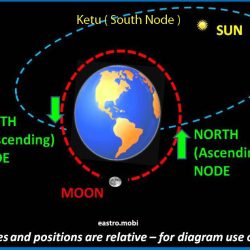I had a problem after my piles operation. Hard stools were coming out with blood, even after the operation ! I panicked, but solved the problem.
“A Banana a day keeps constipation away” was proved true, as I incorporated one ripe banana in my daily diet. My Doctor had told me to lay off non vegetarian and hot food and so I became a vegan ! Hot and sour foods have been eschewed, Eggs are taboo !
Once I made the dietary changes, constipation stopped. I was wondering how I got piles in the first place. If the tertiary cause was piles, the secondary cause was constipation and the primary cause was constipating foods. So I avoid all constipating foods. No milk, as it is dehydrating. No alcohol, as it is also constipating. Fruits and veggies are best
Before my morning tea, I have 3 glasses of water and so I get smooth motion. Now motion and digestion are OK and gone is my constipation !
Isnt constipation the root cause of all diseases ?
Meissa or Mrigasira, the Head of Orion !
The Head of Orion was called by the Rishies as Mriga Sira. Mriga means the beast and Sira means head. Mrigasira is known in Malayalam as Makiryam !
Those born under Mriga Sira ( when the Moon tenants the constellation of Mriga Sira ) were found to be egotists and calumniers ! Ahamkaree paradweshee mrige bhavathi manava.
Makiryam is Meissa !
Blogging is Marketing !
My main blog site, www.eastrovedica.net was not functional for 4 years. Now I got it back and is blogging daily.
Blogging is fun. Blogging gives you satisfaction. I realised after I blogged on my blog site and my 32 blogs on Blogger, that my impressions are going up ! More bandwidth for my sites and blogs. Only that blogging takes a lot of time, but that cannot be helped.
So blogging is the way. Blogging can take you from obscurity to omnipresence !
Chatayam Njattuvela !
In Kerala, the hot season has begun. The sidereal month of Aquarius or Kumbha started on 13th Feb and Kerala is about to reel under a heat wave. Last year the death from sunstrokes was > 100 !
On 19th, Chathayam or Sathabhisha Njattuvela started and so we are ready for a hot phase. Kumbha Choodu and Meena Choodu are famous, as the earth becomes scorched due to lack of rains.
Some summer rains can come, but they cannot sustain ! Till Edava Pathi or the Half of Taurus, we cannot expect major rains ! So a very hot season indicated till Vrishabha or Taurus !
Kerala Tourism to net more than 24 K cr this year !
This year, Kerala Tourism, will net in more than 24000 crores. Responsible Tourism, the Government calls it.
Much investment is needed in infrastructure, if India is to make it up to the level of advanced countries. As such, the 6.4% growth of Indian Tourism and the 8% growth of Kerala Tourism seems to be average.
My trip to Thriprayar
Guruvayur Website !
Amongst the Four Yogas, Bhakti Yoga or Bridal Mysticism is revered.
BM reduces Ego ! In B M, the statement is “I am Thine” and not ” I Am that I Am” !
So we have stated a B M site for students, who want to learn spirituality. Guruvayur4u
This site deals with the esoteric meaning behind Mythology. Mythology is allegorical, the depiction of eternal verities through stories.
Guruvayur4u

Without Bridal Mysticism, without Bhakti Yoga, can any one actualise the Absolute Self ? No !
So we started a Bhakti Yoga site, www.guruvayur4u.com. This site deals with devotion to the Guru or the Master.
Even though Self Actualisation is a selfish desire ! Just hear what the worldly, layman told the Yogi
While the masses are sunk in Ignorance
You want to scale the Eternal’s peaks !
To immerse yourself in Bliss transcendental
Isnt thy desire selfish to the core ?
Regarding the controversial book, The Hindus, An Alternative History by Wendy Doniger
different. Those who study the Exoteric miss the Wisdom of the Esoteric. Just
giving a superficial opinion that religious traditions are mere amalgamations
of many practices exposes the author’s ignorance of Esoteric Wisdom ! She has
not understood what Henry David Thoreau said ” The English sense has toiled, but
Hindu Wisdom never perspires ” or what Annie Besant said ” After a study of 40
years, of all the great religions of the world, I find none so scientific, none
so philosophic, none so systematic as the great Religion we know by the name of
Hinduism” !
understand the Eternal Law, the Santan Dharma ! Neither the Esoteric nor the Exoteric !
The Song Revealed to the Discriminative Intellect by the Self
Revealed by the Absolute Self
Intuited by the Master Mystic, Vyasa
And other Masters of yore
The conferror of Advaitic Wisdom
The true Mother Divine
Composed of eighteen chapters glorious
O Mighty Mother celestial
We bow to Thee !
Parthena Pratibhoditham
Bhagavata Narayanena Swayam
Vyasene Gradhitam
Purana Munina Madhye Mahabharatam
Advaitaamrita Varshineem
Bhagavateem
Ashta Dasa Dhyayinieem
Amba tvam Anu sandhadami
Bhagavat Geethe
Paradvesineem
The Geetha is verily our Mother, a Lamp lit by the Lord, the Science of the Absolute and the Scripture on Yoga. The Lord milked the 16008 Upanishads ( allegorically depicted as His wives ) and the quintessence thus got is this Song Celestial or Bhagavat Geeta.
The Self is Rider
The body intellect
Mind the reins
And chariot human body !
Atmanam Radhinam Viddhi
Sareeram Ratham eva Cha
Buddhim thu Saradhim Viddhi
Mana Pragrahameva cha !












